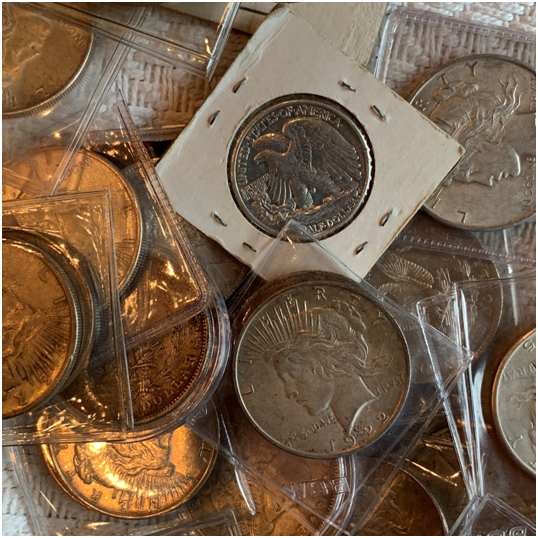
The $20 gold coins, known as Double Eagles, were minted by the United States from 1850 to 1933. Among these, certain issues are particularly rare and highly sought after by collectors. Here are ten of the rarest $20 gold coins:
- 1849 Liberty Head Double Eagle (Pattern Coin): This is the very first $20 gold coin ever minted, with only one known specimen, making it exceptionally rare.
- 1861 Paquet Reverse Double Eagle: Featuring a modified reverse design by Anthony Paquet, this coin had limited production before the design was discontinued, resulting in its rarity.
- 1861 Philadelphia Mint Double Eagle: This coin is notable for its rarity and historical significance, with limited numbers produced during the Civil War era.
- 1861-O Liberty Head Double Eagle: Minted at the New Orleans Mint during the Civil War, this coin is rare due to its low mintage and historical context.
- 1870-CC Liberty Head Double Eagle: As the first $20 gold coin minted at the Carson City Mint, it had a low mintage, making it highly desirable among collectors.
- 1882 Liberty Head Double Eagle: This coin is rare due to its low mintage and limited survival rate, making it a prized piece for collectors.
- 1885 Liberty Head Double Eagle: With a low mintage and few surviving specimens, this coin is considered one of the rarest in the series.
- 1920-S Saint-Gaudens Double Eagle: This coin is rare due to its low mintage and the fact that many were melted down, leaving few survivors.
- 1921 Saint-Gaudens Double Eagle: With a low mintage and high melt rate, this coin is one of the rarest in the Saint-Gaudens series.
- 1933 Saint-Gaudens Double Eagle: Although 445,500 were minted, nearly all were melted down due to the Gold Reserve Act. Only a few are known to exist, making it one of the most famous and valuable coins.
These coins are highly valued not only for their gold content but also for their historical significance and rarity. Collectors seeking these pieces should consult reputable dealers and consider professional grading to ensure authenticity and assess condition.
Here is a more detailed definition of each
- 1849 Liberty Head Double Eagle (Pattern Coin)
The 1849 Liberty Head Double Eagle holds the distinction of being the first $20 gold coin ever minted by the United States. Designed by Chief Engraver James B. Longacre, this pattern coin was produced in response to the California Gold Rush, which significantly increased the nation’s gold reserves. The obverse features a left-facing portrait of Lady Liberty adorned with a coronet inscribed with “LIBERTY,” while the reverse showcases a heraldic eagle with a shield on its breast.
Only one specimen of this coin is known to exist, making it exceptionally rare. This unique piece resides in the Smithsonian Institution’s National Numismatic Collection, serving as a testament to its historical significance. Its exclusivity and status as the inaugural Double Eagle render it invaluable to collectors and historians alike.
The creation of the 1849 Double Eagle marked a pivotal moment in U.S. coinage, introducing the largest denomination gold coin at the time. Its design set the standard for subsequent issues, influencing the aesthetics of American currency. The coin’s rarity and historical importance continue to captivate numismatists worldwide.
Over the years, the 1849 Liberty Head Double Eagle has been the subject of extensive study and admiration. Its unique status and the circumstances surrounding its production offer valuable insights into the economic and cultural landscape of mid-19th century America.
- 1861 Paquet Reverse Double Eagle
In 1861, Assistant Engraver Anthony C. Paquet introduced a modified reverse design for the Double Eagle, featuring taller and more slender lettering compared to the original design by James B. Longacre. This design aimed to enhance the coin’s aesthetic appeal and legibility.
However, concerns arose regarding the durability of the new design, particularly the narrow rim, which was thought to be prone to rapid wear. Consequently, production of the Paquet Reverse was halted shortly after it began. The Philadelphia Mint produced only two known specimens, while the San Francisco Mint struck approximately 19,250 coins before receiving the order to cease production.
The limited mintage and subsequent recall of the Paquet Reverse Double Eagles contribute to their rarity and desirability among collectors. Surviving specimens from the San Francisco Mint occasionally appear in auctions, fetching significant sums due to their scarcity and historical context.
The 1861 Paquet Reverse Double Eagle serves as a fascinating example of mid-19th century experimentation in U.S. coinage design. Its brief production run and the circumstances leading to its discontinuation offer insights into the challenges faced by the U.S. Mint during that era.
- 1861-O Liberty Head Double Eagle
The 1861-O Liberty Head Double Eagle holds a unique place in American history, as it was minted at the New Orleans Mint during a tumultuous period. In 1861, the New Orleans Mint came under the control of three different governments: the United States, the State of Louisiana, and the Confederate States of America. Each authority continued to produce coinage, including the Double Eagle, during their respective control.
The total mintage for the 1861-O Double Eagle was 17,741 coins, but it’s challenging to determine how many were struck under each regime. Coins produced under Confederate control are particularly scarce and hold significant historical interest.
The complex history of the 1861-O Double Eagle, coupled with its low mintage, makes it a prized piece among collectors. Its association with the Civil War and the Confederacy adds to its allure and historical significance.
Surviving specimens of the 1861-O Double Eagle are rare, especially those in higher grades. Collectors highly value these coins for their historical context and the story they tell about a divided nation during the Civil War.
- 1870-CC Liberty Head Double Eagle
The 1870-CC Liberty Head Double Eagle is notable for being the first $20 gold coin minted at the Carson City Mint in Nevada. Established to process the vast amounts of silver and gold from the Comstock Lode, the Carson City Mint produced coinage that is now highly sought after by collectors.
With a mintage of only 3,789 coins, the 1870-CC Double Eagle is one of the lowest mintage issues in the series. Many of these coins saw extensive circulation in the rugged Western frontier, leading to a low survival rate, especially in higher grades.
The “CC” mintmark on these coins adds to their desirability, as Carson City issues are synonymous with the Wild West era. The 1870-CC Double Eagle, in particular, is a centerpiece for collectors of Carson City coinage.
Due to its low mintage and historical significance, the 1870-CC Double Eagle commands high prices at auction. Collectors prize this coin not only for its rarity but also for its connection to the rich history of the American West.
- 1882 Liberty Head Double Eagle
The 1882 Liberty Head Double Eagle is a rare issue with a mintage of only 571 coins, making it one of the lowest mintage Double Eagles produced.
This low production was due to a decreased demand for large denomination gold coins during that period.
Many of the 1882 Double Eagles were likely melted down or lost, resulting in a limited number of surviving specimens. Those that do exist are highly sought after by collectors, especially in higher grades.
The rarity of the 1882 Double Eagle, combined with its classic Liberty Head design, makes it a prized addition to any collection. Its scarcity ensures that it commands significant premiums in the numismatic market.
Collectors seeking the 1882 Double Eagle should be prepared for competitive bidding and substantial investment, reflecting
- 1885 Liberty Head Double Eagle
The 1885 Liberty Head Double Eagle is among the rarest issues in the series, with a total mintage of only 751 coins. This exceptionally low production was due to limited demand for large denomination gold coins during that period. As a result, surviving specimens are scarce, especially in higher grades.
Most known examples of the 1885 Double Eagle are in circulated conditions, with uncirculated pieces being exceedingly rare. The few that exist are highly prized by collectors and often command significant premiums at auctions. The coin’s classic Liberty Head design, coupled with its rarity, adds to its desirability among numismatists.
The 1885 Double Eagle’s scarcity is further compounded by the fact that many were likely melted down over the years, reducing the number of surviving specimens. This makes it a challenging coin to acquire, even for seasoned collectors.
When available, the 1885 Double Eagle typically appears in grades ranging from Very Fine (VF) to About Uncirculated (AU). Uncirculated examples are particularly rare and can fetch substantial sums, reflecting their importance in American numismatic history.
- 1920-S Saint-Gaudens Double Eagle
The 1920-S Saint-Gaudens Double Eagle is a notable rarity within the series, with a mintage of 558,000 coins. Despite this relatively high production number, the majority were melted down during the 1930s as a result of the Gold Reserve Act, making surviving specimens scarce.
The few examples that escaped melting are highly sought after by collectors, especially those in uncirculated condition. The coin features the iconic design by Augustus Saint-Gaudens, depicting Lady Liberty striding forward on the obverse and a majestic eagle in flight on the reverse.
The 1920-S Double Eagle’s rarity is further accentuated by the fact that many of the surviving coins exhibit significant wear, as they were circulated before being recalled. High-grade examples are particularly rare and command substantial premiums in the numismatic market.
Collectors seeking the 1920-S Double Eagle should be prepared for competitive bidding and significant investment, reflecting the coin’s scarcity and historical significance.
- 1921 Saint-Gaudens Double Eagle
The 1921 Saint-Gaudens Double Eagle is one of the most coveted coins in American numismatics, with a mintage of only 528,500 coins. Similar to the 1920-S issue, the majority were melted down during the 1930s, leaving very few survivors.
The coin features the renowned design by Augustus Saint-Gaudens, considered by many to be one of the most beautiful in U.S. coinage. The obverse depicts Lady Liberty holding a torch and olive branch, while the reverse showcases a soaring eagle.
Surviving specimens of the 1921 Double Eagle are rare, especially in higher grades. Uncirculated examples are particularly scarce and can command prices well into six figures at auctions.
The 1921 Double Eagle’s rarity and aesthetic appeal make it a centerpiece for collectors of U.S. gold coins. Its limited availability ensures that it remains a highly sought-after piece in the numismatic community.
- 1930-S Saint-Gaudens Double Eagle
The 1930-S Saint-Gaudens Double Eagle is another significant rarity in the series, with a mintage of 74,000 coins. However, like other issues from this period, the vast majority were melted down following the Gold Reserve Act of 1934, leaving very few survivors.
The coin features the classic Saint-Gaudens design, admired for its artistic excellence. The obverse depicts a full-length figure of Liberty, while the reverse shows an eagle in flight above the sun.
Surviving examples of the 1930-S Double Eagle are extremely rare, particularly in uncirculated condition. High-grade specimens are highly prized by collectors and can fetch substantial sums at auction.
The 1930-S Double Eagle’s scarcity and historical context make it a highly desirable piece for numismatists. Its limited availability ensures that it remains a highlight in any collection of U.S. gold coins.
- 1933 Saint-Gaudens Double Eagle
The 1933 Saint-Gaudens Double Eagle is perhaps the most famous and controversial coin in American numismatic history. Although 445,500 were minted, none were officially released into circulation due to President Franklin D. Roosevelt’s executive order halting the issuance of gold coins.
The majority of the 1933 Double Eagles were melted down, but a few specimens managed to escape destruction. One such coin was sold at auction in 2002 for over $7 million, setting a record at the time.
The 1933 Double Eagle’s rarity and the legal battles surrounding its ownership have only added to its mystique. It remains a symbol of a pivotal moment in U.S. monetary history and is highly coveted by collectors worldwide.
Due to its unique status, the 1933 Double Eagle is often regarded as the “Holy Grail” of coin collecting. Its story continues to captivate numismatists and the general public alike.


